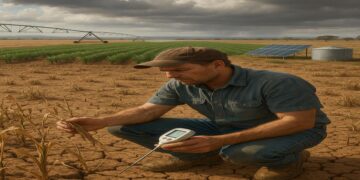The Impact of Climate Change on Agricultural Investments in Australia

Understanding Climate Change’s Role in Agriculture
The agricultural sector in Australia is currently facing a transformative period due to the ramifications of climate change. Investors need to be acutely aware of how shifting environmental conditions can greatly influence agricultural productivity and profitability. By understanding both the risks and potential benefits associated with these changes, stakeholders can make informed decisions that will sustain the sector through challenging times.
Temperature Variability
Rising temperatures are a critical aspect of climate change that directly impacts crop yields and livestock health. For example, staple crops like wheat and barley are sensitive to temperature fluctuations; if the average temperature increases beyond optimal growing conditions, yields can dramatically decrease. The Australian Grain Industry is currently exploring varieties that are more heat-tolerant, enabling farmers to maintain productivity under hotter conditions.
Rainfall Patterns
Alongside temperature changes, alterations in rainfall patterns pose significant challenges. Australia has always been known for its volatility in weather, but climate change is intensifying this. Regions that traditionally enjoyed consistent rainfall may suddenly face prolonged droughts, leading to reduced water availability for irrigation. Conversely, areas may experience heavy downpours that can cause flooding, damaging crops and soil health. For example, the flooding events in New South Wales in 2022 highlighted vulnerabilities within the farming industry, affecting both crops and livestock operations. Investors should consider the geographical distribution of rainfall changes when evaluating agricultural investment opportunities.
Pest and Disease Pressure
Climate change also alters the dynamics of pest and disease pressure on crops. Warmer temperatures can expand the geographical range of various pests, such as locusts, which have historically wreaked havoc in Australian agriculture. Farmers may need to increase their reliance on pesticides, which raises production costs and raises sustainability concerns. However, this challenge can serve as an impetus for innovation, driving investment into organic solutions and biopesticides that are less harmful to the environment.
Opportunities for Sustainable Practices
While the challenges of climate change are significant, they also create a fertile ground for innovative agricultural practices and technologies. For instance, investments in sustainable farming methods, such as permaculture and regenerative agriculture, can not only offer potential financial returns but also enhance resilience against climate fluctuations. Additionally, investing in drought-resistant crops, such as certain legume varieties, can help safeguard against variable weather patterns. These advancements may also appeal to a growing consumer base that is increasingly prioritizing sustainability.
Strategic Adaptation for Investors
As the impact of climate change becomes more pronounced, it is vital for investors to remain informed and prepared to adapt. This shift may involve reviewing current portfolios to include more climate-resilient agricultural projects or exploring partnerships with technologies that support sustainable farming practices. By staying ahead of the curve, investors can help mitigate risks associated with climate impacts while seizing opportunities for growth in an ever-evolving landscape.
This article aims to equip readers with insights and practical guidance on navigating the complexities of agricultural investments in a changing climate, emphasizing the importance of proactive approaches in this critical sector.
Climate Risks Facing Australian Agriculture
Australia’s agriculture is deeply interwoven with its unique climate, and the imminent impacts of climate change present a pressing challenge for investors in this sector. The combination of rising temperatures, changing rainfall patterns, and increased pest pressures forms a triad of risks that can undermine agricultural productivity. Understanding these risks is essential for making sound investment decisions.
Implications of Temperature Increases
The warming of the planet is not just a distant concern; increasing temperatures are already affecting the agricultural landscape in Australia. For crops such as wheat, which are crucial to both local consumption and export, optimal temperature ranges are critical for achieving maximum yields. As temperatures rise, reaching levels beyond what is suitable for these crops, farmers could see a significant decline in production. For instance, in recent years, some wheat-growing regions have reported yield losses of up to 30% due to extreme heat events. This situation forces investors to reassess the viability of their current projects and consider investing in heat-resilient crop varieties, which can sustain yield even in harsher conditions.
Changing Rainfall Patterns
In addition to temperature, changes in rainfall patterns are also altering the agricultural landscape. Australia is notorious for its diverse climates, ranging from the arid interior to the lush coastal regions. However, the unpredictability brought on by climate change means that regions once reliable for certain crops may suddenly become less suitable. For example, farmers in Victoria have experienced erratic rainfall, leading to water shortages that threaten both irrigation and pasture management. Conversely, areas may be subjected to intense rainfall, resulting in floods that can inundate fields and disrupt planting schedules. To navigate these uncertainties, investors should consider a range of strategies, including:
- Investing in advanced irrigation technologies that optimize water usage.
- Assessing soil health to enhance water retention capacities.
- Exploring crop rotations that use less water or require less rainfall.
Increased Pest and Disease Risks
As the climate continues to change, the pressures from pests and diseases also escalate. Warmer temperatures create ideal conditions for certain pests, allowing them to thrive beyond their historical limits. For instance, the Queensland fruit fly has become a prominent threat to horticulture, affecting fruit yields and increasing management costs. Farmers may find their pesticide expenses rising as they strive to combat these invasions, which can erode profit margins. This dynamic encourages the agricultural sector to innovate, pushing for investments in environmentally friendly pest management solutions, such as biological control measures and integrated pest management systems.
Fundamentally, climate change poses significant risks to Australia’s agricultural investments, demanding that investors and farmers alike adapt. By understanding these challenges, stakeholders can make proactive decisions that safeguard and potentially enhance the future of agricultural productivity in Australia. The ability to pivot and innovate will be key in maintaining resilience amidst these changing conditions.
Adapting Agricultural Investments to Climate Challenges
For investors in Australia’s agriculture sector, adapting to the realities of climate change requires not only recognising the risks but also seizing the opportunities that arise from these challenges. Smart investments can play a pivotal role in increasing resilience against climate impacts while simultaneously ensuring sustainable growth in agricultural outputs.
Investing in Sustainable Practices
One response to climate change lies in sustainable agricultural practices. Transitioning towards methods that promote environmental health not only improves long-term productivity but also attracts investors increasingly focused on sustainability. For example, regenerative agriculture—which includes practices such as cover cropping, no-till farming, and agroforestry—can enhance soil health and mitigate carbon emissions. Evidence from various Australian farms shows that these practices can increase yield stability over the long term, making them an attractive prospect for investors aiming for both ecological and financial returns.
Climate-Smart Technologies
The adoption of climate-smart technologies presents another avenue for enhancing agricultural resilience. Precision agriculture, which employs techniques such as remote sensing and data analytics, allows farmers to maximise yields while minimising resource use. By investing in technologies like drones for crop monitoring, soil moisture sensors, or automated irrigation systems, farmers can pivot their strategies based on real-time data. Such innovations enhance productivity while conserving water and reducing the environmental footprint of agricultural operations. Investors can play a crucial role by funding these technologies, potentially leading to higher returns through increased efficiency.
Diversification Strategies
In response to the increasing unpredictability of climate conditions, diversifying crops and livestock can help spread risk among agricultural investments. By encouraging farmers to grow a broader variety of crops—such as drought-resistant grains or native plant species—investors can promote practices that better prepare for climatic variances. For instance, research indicates that regional farmers growing a mix of canola and legumes have seen greater resilience in yield and profitability during dry spells compared to mono-crop operations. Investments in farmland with diverse agricultural systems not only lower the risks of total crop failure but also contribute to ecological stability.
Research and Development Partnerships
Engaging in research and development (R&D) partnerships is another effective approach for investors. Collaborating with academic institutions, agricultural research organisations, and tech companies can accelerate the development of innovative farming solutions tailored for Australian conditions. For example, R&D focused on breeding new crop varieties that withstand heat or pest pressures promises to yield substantial long-term benefits. Not only does this foster innovation but it also positions investors at the forefront of emerging trends in the agricultural landscape.
Ultimately, the effective management of climate change impacts presents both challenges and opportunities for agricultural investors in Australia. By diversifying investments, adopting sustainable practices, leveraging technology, and engaging in R&D, stakeholders can spearhead a transformation that fosters resilience in the face of an uncertain climate future.
Conclusion
In summary, the intersection of climate change and agricultural investments in Australia poses significant challenges yet also opens the door to innovative solutions. Investors have a vital role in shaping a sustainable agricultural future by recognising that a shift in investment strategies is essential for enduring success. By prioritising sustainable practices and supporting climate-smart technologies, they can contribute to enhancing the resilience of the agricultural sector against unpredictable climate conditions.
Moreover, the promotion of diversification strategies and investments in R&D partnerships creates fertile ground for innovation and stability. As farmers adopt a broader range of crops and livestock, they can better withstand the shocks of climate variability while also engaging in practices that enrich biodiversity. This dual objective aligns well with the growing trend of environmental consciousness among investors, who are increasingly recognising the financial value of sustainability-focused ventures.
Looking ahead, it is vital for stakeholders in Australia’s agricultural landscape to embrace a forward-thinking approach. By adapting their investment strategies to incorporate resilience, sustainability, and collaboration, investors can not only safeguard their financial interests but also contribute to the health of the planet. Ultimately, addressing climate impacts is not just about mitigating threats but also about fostering a thriving agricultural sector that can sustain future generations. Together, we can transform challenges into opportunities and ensure prosperity in the face of change.

James Carter is a financial writer and advisor with expertise in economics, personal finance, and investment strategies. With years of experience helping individuals and businesses make complex financial decisions, James offers practical insight and analysis. His goal is to give readers the knowledge they need to achieve financial success.






